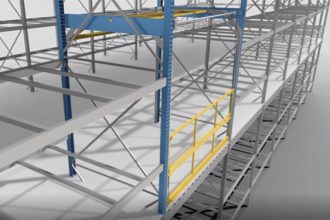7 Tips For Protecting Loading Dock Employees

The loading dock can be one of the busiest spaces within a building. Vehicles of all sizes (vans, box trucks, tractor-trailers) are coming and going. Dock doors are opening and closing. Pallets and cartons are being loaded and unloaded, either directly to or from the trailer at the dock door opening or with a dock lift. Loaded and empty forklifts and pallet jacks are navigating the area. Drivers who work for third parties are entering and leaving the facility. All this activity means an increased risk of injury to persons in the area. Here, a look at six tips for enhancing safety at the loading dock.
- Protect ledges at open dock doors. When a trailer is parked at the dock, its interior floor is level with the building floor. When the trailer departs, however, if the dock door isn’t closed it leaves an opening that poses a fall hazard to associates. That’s why it’s important to install a secondary barrier to secure the ledge when a trailer is not in place. These devices may roll across the floor, expanding a series of crossbars accordion-style, when pulled across the opening by a worker. When a trailer is in place, the barrier is pushed back to the side and the crossbars collapse against each other for compact storage. Alternately, barrier can be hinged in the middle, allowing it to fold up into an A-frame shape for storage. A third style is similar to a railway crossing guard gate that pivots up and down from one side.
- Select dock door barriers appropriate to the environment. Operations with heavy forklift traffic should install open dock door barriers or gates engineered with sufficient impact resistance to prevent the vehicle from toppling off the ledge. In addition to offering impact resistance for operator safety, these gates also protect dock doors, which are typically not strong enough to sustain a forklift impact. They can also protect a dock door from pallet damage, should a dock bay be used for short-term storage during loading and unloading. A suitably rated impact resistant dock gate prevents closed dock doors from damage due to pallets being pushed against them.
- Ensure dock opening guards are ergonomic. If the protective barriers or gates described above are too heavy, awkward, or inconvenient to operate, then workers probably won’t use them — thereby negating the protection of the open dock ledge. Alternately, in particularly busy facilities, the barriers are likely to be applied and removed repeatedly throughout a shift. That increases the risk of repetitive stress injuries from pushing, pulling, or lifting. For those reasons, if the barriers and gates are to be operated manually, it is critical to ensure that they feature ergonomic design and operation. Key features include smooth, easy-rolling wheels for barriers that are pulled and pushed across the floor, or gas springs to make lifting a gate as effortless as possible.
- Automate protective guarding to ensure use. Workers are, after all, human. Chances are therefore high that they might forget to use the protective barriers every time a truck pulls away from an open dock door. To ensure the guarding is deployed consistently, invest in an automated system. A variety of interlocking devices are available; they typically follow a sequence that requires the trailer’s rear impact guard (RIG) to be secured with a latch in order for the safety barrier to be released. When the trailer is unlatched, the guarding automatically returns to its secured position.
- Prevent falls from the open ends of dock lifts. Although the vast majority of dock lifts — whether pit-mounted or surface-mounted — include siderails, there typically are no permanent protective barriers at the loading and unloading ends of the devices. That may present a fall hazard when the dock lift is raising up to, or lowering down from, its elevated height. Ideally, guarding for dock lifts should be a pair of gates attached at end of the lift that open and close automatically, either swinging in or lowering down as the lift elevates, and opening once it is lowered.
- Use different protective devices to accommodate traffic flow. Depending on the layout of the dock and trailer yard, different styles of guarding may need to be used in different areas. Pay attention to the surrounding space when evaluating different types of barriers to ensure their installation and use won’t obstruct vehicles, personnel, or other access openings. For example, a collapsed accordion-style barrier may be blocked on one side by mechanical equipment, necessitating a different barrier type be used on some dock doors. A gate that pivots in one direction may not be ideal in a position next to an egress door if it blocks access to the exit. It’s perfectly acceptable to use different styles of guarding in the same space, if necessary, to accommodate the layout and traffic patterns.
- Secure entrances for guests. Not everyone on the dock will be an employee of the facility; drivers enter and exit with paperwork throughout the day, for example. For their safety — and that of employees — safety cages placed at any egress door dock entry points prevent further access into a building. This prohibits drivers from freely walking around the dock area, which could put them at risk of being struck by a forklift or other moving vehicle. It also provides a way for dock supervisors or managers to enhance the safety of their team members and prevent potential theft from an outsider.
Looking for more ways to protect your workers in your facility? The members of the Protective Guarding Manufacturers Association (ProGMA) have published a series of case studies showing how other companies use safety barriers throughout their operations.



